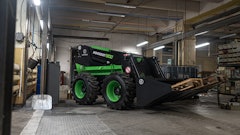
Maximizing “return on investment” (or ROI) is every fleet’s goal. This certainly applies to truck tires. Proper maintenance is important if fleets want to get optimal performance and service life out of their truck tires. But sometimes it’s hard to know just where to begin.
According to Tim Miller, marketing and communications manager for Goodyear Commercial Tire, the following three factors combine to provide a smart “jumping off point” when it comes to tire and/or truck maintenance. Keep them in mind when thinking about your truck tire ROI:
1. Air pressure maintenance. Simply put, maintaining correct inflation pressure is the single most effective thing you can do to positively impact tire wear, casing life and overall tire performance.
“Both over-inflation and under-inflation change the tire’s footprint, which can result in irregular wear and loss of traction,” Miller says. “Although over-inflation can create a handful of issues – harsh ride, for example – it’s under-inflation that can create a number of problems that can cost you time and money.”
According to Miller, air inside the tire actually carries the truck’s load, so under-inflation causes the tire to flex more as it rolls down the road. “That results in internal heat build-up,” he says. “And heat is a tire’s greatest enemy. It causes a tire’s components to deteriorate and may even damage the tire’s steel cords. Insufficient inflation also hurts fuel economy since under-inflated tires force truck engines to work harder.”
Tires are designed to run at specific pressures based on the load they are carrying. To determine the appropriate inflation level for your truck tires, Miller says to gather information about your axle loads and refer to standard load charts, such as the kind you can find at http://www.goodyeartrucktires.com/.
“Operating speed also plays a role,” Miller says. “The tire industry provides guidelines for allowing increased maximum loads if vehicle speeds are reduced. (Think of large cranes that need to carry heavy loads but move very slowly.) Slowing down has bonuses too -- over-the-highway truck drivers can gain a fuel consumption ‘bonus’ simply by using less throttle? Fuel economy tests have shown that fuel consumption increases by 0.1 miles per gallon for every mile-per-hour over 55.
“Another thing to keep in mind is that ambient temperature has an impact on inflation levels. Pressure drops one pound for every 10-degree increase in ambient temperature.”
2. Truck alignments. Keeping your vehicle properly aligned requires an up-front investment but it pays dividends in helping your tires achieve longer life. Are your trucks on a periodic alignment program?
“They should be,” says Miller. “Over time, a good alignment program can boost your tire mileage by as much as 30 percent. Alignments also can reduce the occurrence of irregular tread wear. For instance, steer axle toe-out causes excessive wear on the inside of the tire. Toe-in can cause wear on the outside shoulder.”
When thinking about alignments, Miller says to remember that a traditional front-end alignment isn’t enough. Drive axles must be brought into alignment, making sure they are perpendicular to the chassis, and in the case of tandem axles, parallel to each other.
“Misaligned drive axles affect the wear of drive axle tires, but also affect steer axle tire wear when the driver has to turn slightly left or slightly right to keep a truck moving in a straight line,” Miller says. “Similarly, trailer axles that are out of alignment can be problematic. Vehicle misalignment can negatively impact truck fuel economy, as well. If any of the wheels on an 18-wheeler tractor/trailer are not in alignment, the total drag on the vehicle increases. You will want to avoid this if lowering your fleet’s fuel bill is a concern.”
Alignments are a key ingredient of any good tire and vehicle maintenance program – and misalignment is a condition that does not correct itself. An improperly aligned truck requires expert care.
3. Visual inspections. Chances are, if you’ve been around the trucking industry long enough, you’ve probably heard the old term “kick the tires.”
“While we don’t recommend kicking as a way to measure a truck tire’s roadworthiness, you certainly can learn a lot about a tire through visual inspection,” says Miller. “Regular, visual tire inspections can provide a lot of useful information about a tire’s current (and future) state. Things to check for include unusual wear patterns like feathering or cupping. It’s important to make immediate note of wear patterns. If detected early enough, they can be countered or corrected to help extend tire life.”
Running your hand over a tire’s tread and feeling for abnormalities also will put you more “in tune” with the tire. “While feeling the tread, you should inspect the whole tire for damage such as cuts, cracks, blisters or bulges,” Miller continues. “If the damage is severe, the tire should be taken out of service.”


























